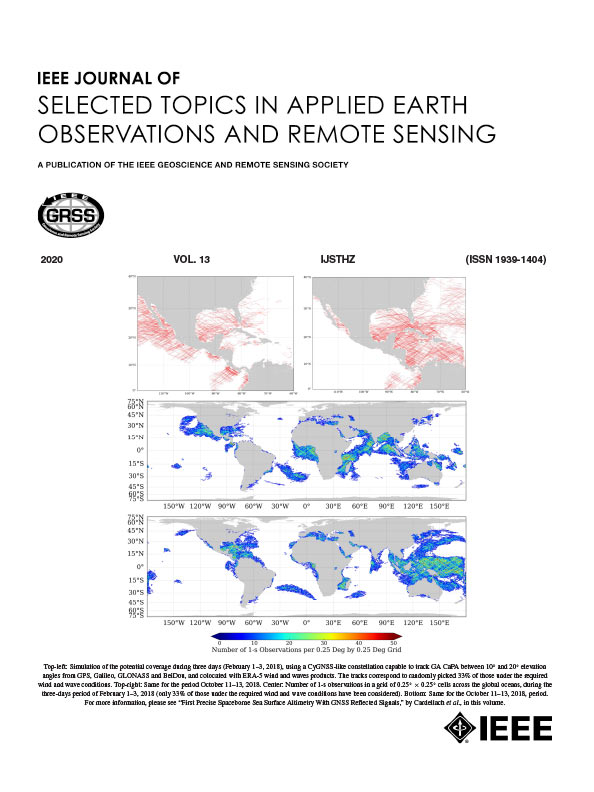A Progressive Spectral Correction and Spatial Compensation Network for Pansharpening
IF 4.7
2区 地球科学
Q1 ENGINEERING, ELECTRICAL & ELECTRONIC
IEEE Journal of Selected Topics in Applied Earth Observations and Remote Sensing
Pub Date : 2025-04-10
DOI:10.1109/JSTARS.2025.3559582
引用次数: 0
Abstract
Pansharpening aims to produce a high resolution multispectral image by fusing a panchromatic image with a low-resolution multispectral image. Current pansharpening methods often overlook the significant modality differences between source images and lack interaction between them, resulting in spatial-spectral distortions. To address these issues, we proposed a novel progressive spectral correction and spatial compensation network for pansharpening. The network comprises a spectral correction branch, a spatial compensation branch, and a spectral-spatial fusion (SSF) branch. In the spectral correction branch, we designed a local spectral reinforcement (LSR) module and a global spectral rectification (GSR) module to keep the spectral fidelity. The LSR module is designed to reinforce the unique local information from different kinds of spectral features, while the GSR module captures long-range dependency and rectifies the spectral features with a cross-attention mechanism. In the spatial compensation branch, we designed a multiscale dilated adaptive feature extraction module guided by spectral and spatial attention to extract useful spatial details, and the details are progressively compensated into the SSF branch to better keep spatial fidelity. The SSF branch is designed to interact with spectral correction branch and spatial compensation branch to mitigate the modal difference and progressively optimize the spectral-spatial information. Comprehensive experiments show that the proposed method outperforms current state-of-the-art pansharpening methods.一种用于泛锐化的递进光谱校正和空间补偿网络
泛锐化的目的是通过融合全色图像和低分辨率多光谱图像来产生高分辨率的多光谱图像。目前的泛锐化方法往往忽略了源图像之间明显的模态差异,缺乏源图像之间的相互作用,导致空间光谱失真。为了解决这些问题,我们提出了一种新的渐进光谱校正和空间补偿网络用于泛锐化。该网络包括一个光谱校正分支、一个空间补偿分支和一个光谱-空间融合分支。在光谱校正分支中,我们设计了局部光谱增强(LSR)模块和全局光谱校正(GSR)模块来保持光谱保真度。LSR模块旨在从不同类型的光谱特征中增强独特的局部信息,而GSR模块则捕获远程依赖并通过交叉注意机制对光谱特征进行校正。在空间补偿分支中,我们设计了以光谱和空间注意力为导向的多尺度扩展自适应特征提取模块,提取有用的空间细节,并将这些细节逐步补偿到SSF分支中,以更好地保持空间保真度。SSF分支与光谱校正分支和空间补偿分支相互作用,缓解模态差异,逐步优化光谱空间信息。综合实验表明,该方法优于当前最先进的pansharpening方法。
本文章由计算机程序翻译,如有差异,请以英文原文为准。
求助全文
约1分钟内获得全文
求助全文
来源期刊
CiteScore
9.30
自引率
10.90%
发文量
563
审稿时长
4.7 months
期刊介绍:
The IEEE Journal of Selected Topics in Applied Earth Observations and Remote Sensing addresses the growing field of applications in Earth observations and remote sensing, and also provides a venue for the rapidly expanding special issues that are being sponsored by the IEEE Geosciences and Remote Sensing Society. The journal draws upon the experience of the highly successful “IEEE Transactions on Geoscience and Remote Sensing” and provide a complementary medium for the wide range of topics in applied earth observations. The ‘Applications’ areas encompasses the societal benefit areas of the Global Earth Observations Systems of Systems (GEOSS) program. Through deliberations over two years, ministers from 50 countries agreed to identify nine areas where Earth observation could positively impact the quality of life and health of their respective countries. Some of these are areas not traditionally addressed in the IEEE context. These include biodiversity, health and climate. Yet it is the skill sets of IEEE members, in areas such as observations, communications, computers, signal processing, standards and ocean engineering, that form the technical underpinnings of GEOSS. Thus, the Journal attracts a broad range of interests that serves both present members in new ways and expands the IEEE visibility into new areas.

 求助内容:
求助内容: 应助结果提醒方式:
应助结果提醒方式:


